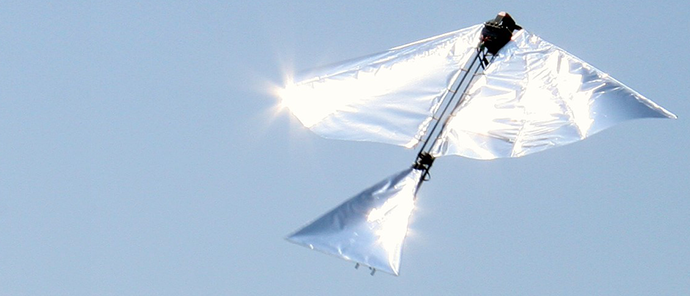Robo-Raven is a new reconnaissance and surveillance drone developed by the Army Research Laboratory. Detectible to radar, this drone isn't stealth. But it adds some new and unique twists to what we normally associate with camouflage.
As a surveillance and reconnaissance drone, the small Robo-Raven is designed to
gather information while flying over a stationary or mobile target.
However, these basic functions, alone, would make it little different from
any other military drone.
Robo-Raven
However, reconnaissance
and surveillance aren‘t Robo-Raven‘s only functions. It's also designed
to accomplish its mission while being observed, but not identified. In
other words, Robo-Raven is designed not just to look like a bird, but to be, reliably, mistaken for a bird.
Making a military combat or reconnaissance device look like something else is
nothing new. It’s camouflage.
During World War II, airplanes were painted a particular color and outfitted
with carefully positioned lights, which made them blend into the sky.
This delayed identification by ground spotters and allowed an addition measure
of surprise.
Military vehicles are painted with an irregular green, gray, brown, and black
pattern to blend into surrounding foliage. Now used in fashion clothing,
that particular color pattern retains the name “camouflage.”
However, these examples use paint and lights (counter illumination) to achieve
visual crypsis. Crypsis is a type of camouflage in which an object is
designed to blend in with a certain type of background, making the object
difficult to see or detect.
However, Robo-Raven adds something new to drone technology with perhaps one of
the most advanced and innovative uses of mimesis. Mimesis is another form
of camouflage less mysteriously called masquerade: the camouflaged
object looks like something else, which is of no special interest to the
observer.
Robo-Raven
Robo-Raven is designed not only to look like a bird, but also to move like a
bird. The drone's wings are designed to move independently and make its
bodily movements more naturally match those of a bird. But that’s not
all. This drone's pattern of flight is characteristic of a bird.
Robo-Raven
So, to improve its masquerade, Robo-Raven is equipped with a substantial set of
animatronic movements replicating a bird’s kinesics (body language) and manner
of flight. Borrowed from Hollywood, animatronics is the art and
technology of designing mechanical models of animals that move like the real
thing. These models are used to create the illusion of real animals for
film audiences. However, Hollywood’s animatronics is about entertainment,
while Robo-Raven’s animatronics is about concealment.
Robo-Raven isn’t just a camouflaged object that moves, it’s animatronic
movements are part of its camouflage -- part of it’s masquerade. But
Robo-Raven’s masquerade doesn’t end with its appearance and movement. It
has something more. Something that takes it even more deeply into the
world of biorobotics
The term biorobotics refers to a special sub-field of robotics: the study of how
to make robots emulate or simulate living biological organisms. For
example, when students of animal behavior observed that the leader of a school
of fish beat, or swished, its tail with greater frequency than the followers in
the rest of the school, they formulated the question: Does a particular tail
movement make a particular fish the leader of a school?
To answer this question, researchers at the Polytechnic Institute of New York
University used a basic form of biorobotics. They designed a
"bio-inspired" robotic fish, which mimics the tail movements of a
swimming fish. This robotic fish's tail
could be set to beat at different speeds by remote control. When
researchers placed their robotic fish in a water tunnel with a school of golden
shiner fish, the robotic fish was ignored. But when its tail speed was
set on high, it became the leader.
The robotic fish was more than just a robot with animatronic movements designed
to entertain or even fool human beings. Its movements were designed to
fool other fish. And Robo-Raven can do the same with other birds.
John Gerdes, mechanical engineer with the Aberdeen Proving Ground has reported that Robo-Raven "already attracts the attention" of birds in its area. "[S]eagulls, crows, and songbirds have flown around the Raven in formation" and the drone has been attacked (unsuccessfully) by "hawks and falcons." [video] So, Robo-Raven’s animatronic movements not only fool humans, they also fool other birds.
Robo-Raven Attacked by a Hawk
Of course, Robo-Raven is designed to fool human observers into believing
that it’s a bird. But this drone's ability to fool real birds is not just
an interesting sidelight -- it was one of the design objectives. Fooling
other birds is yet another level of Robo-Raven’s masquerade.
The designers understood that this drone’s “social interaction” with other
birds would also be observed by humans. When Robo-Raven is seen flying
with a flock of real birds or being attacked by real birds, human observers
will be all the more certain that Robo-Raven is "just a bird" -- not
a reconnaissance and surveillance drone.
So, Robo-Raven’s masquerade is composed of its appearance, its movements and,
even, its interactive behavior. In other words, this drone has the
appearance and movements of a bird plus something more. Robo-Raven has
the behavior of a bird among birds.
Robo-Raven is a substantial step forward in both drone technology and
biorobotics: a robot that, outwardly, so closely resembles a bird that it
becomes more difficult for people or animals to distinguish between the real
and the robotic. In the future, we may all be eying the birds around us
-- wondering whether they’re really birds. This technology certainly turns the
table on birdwatchers. Who’s watching who?
See also:
ROBO-RAVEN'S SURVEILLANCE CAMERA/TRANSMISSION:
See also:
ROBO-RAVEN'S SURVEILLANCE CAMERA/TRANSMISSION:
Surveillance Camera/Transmission
ROBO-RAVEN'S NEW SOLAR CELLS:
Robo-Raven: Solar Cells Installed in Wings
FROM UK: HOW ROBO-RAVEN WILL BE DEPLOYED
[Please be patient. Robo-Raven's story is the third of three in the video below]
How Robo-Raven will be Deployed






No comments:
Post a Comment